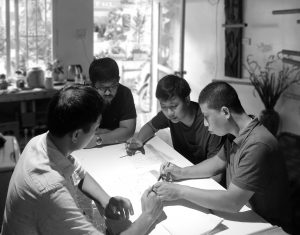Kecho Studio
Kecho studio
30th March 2020 8:45 GMT
Our story
People
Design Philosophy
Approach

Kecho Design Studio
Kecho design studio offers a wide range of workshops, inspired by the crafts of the villages around Hanoi. These crafts involve natural materials such as bamboo, wood, clay etc. By doin the workshop, we hope to increase awareness of these crafts (some crafts are already in the verge of disaapearing), thus help to sustainable thosee communities and at the same time provide new skills for the participants.
Beside the tranditional crafts, our own day presents ourselves new crafts, from the humanity field like creative writing to the technological driven “crafts” like digital modeling in architectural design. The emergence of these new crafts are necessary to deal with our increasingly complex problems of our time.
What is really interesting is that the old and the new have similarity, most of the time. beside some breakthroughs in technologies, in art and architecture, the past have been provern to greatly influence our moden design methodologies. We can cite some of the examples like space syntax, patterns, behaviours, or even “parametric” design.
The proposed bamboo joints for tensegrity structure are fall under many categories based on their load
Timeline

Our Story
Imran Perretta: I studied it at school around the time the Twin Towers came down and it was also around that time that my body was growing at this exponential rate and I started to be seen as a public threat. I think reading the story about these young boys and how they were marked for their capacity for violence chimed with me because that was the way in which my body was also starting to be seen and it was a very uncomfortable realisation. The boys in the story were seeing this man’s house in a time of devastation just after the Blitz and I was interested in the parallel with the beginnings of the war on terror around the same time. So there were all these cultural and historical markers that meant that my narrative had this sort of eerie symbolic relationship with the narrative in the short story and this has always stuck with me.
People
I was interested in talking about a specific experience of structural oppression and Islamophobia in the hope that, if I spoke very lucidly about some of the things I’ve seen, then it would resonate in one way or another with people who had seen or heard something similar. I was reticent to talk about political forces like austerity and the war on terror in generic terms or just as pieces of legislation when what they do is affect families and individuals in a very intimate way. So what I was trying to do was to use very intimate and personal experiences of having been wronged as a way of aiming upwards at the state and authoritarian politics. I’m coming from a position of trying to critique power structures that have laid a path for me, and I can only do that in an embodied way, otherwise I’d be a commentator rather than someone who has actually experienced these things.
Design Philosophy
The building is a community centre that is slowly falling into disrepair because the local council budget was under austerity measures. I wanted to draw attention to its slow decay and the fact that if you erode social provision, what you are eroding are communities, families and real people and so the building becomes a protagonist in the work. You see liquid and gas entering the space as this sort of ingress, these insidious outside forces creeping in as well as drawing attention to the fact that the building is porous and falling apart.
Approach
The core interest for me is how to reference images from conflict and war without actually having to show them—how you reference violence, especially state violence and material devastation, without having to show the people or the places that have suffered in reality. That is really important. We have become so accustomed to seeing black and brown deaths on television and to seeing certain bodies treated with a certain sort of callousness and coldness by the camera. So for me it is how can you show and allude to violence and conflict without actually having to show its real-life effects? How to talk about the things we’ve endured without having to further endure them, that is part of the mission, the political strategy of the work.
I also have an interest in magic realist literature, particularly that which references colonialism, like Salman Rushdie’s Midnight’s Children. It has this sense of the uncanny, of something that is very close to real life but is in some way extraordinary and abstracted and of using that distance, that suspension of disbelief to talk about things that are historically or culturally traumatic. For me visual effects tap into that idea of the uncanny and how you can create a slightly otherworldly scenario that is actually concretely rooted in the real world, and is almost truer than the truth.




